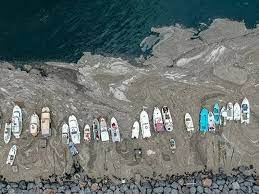Sea Snot:

Turkey’s Sea of Marmara, that connects the Black Sea to the Aegean Sea, has witnessed the largest outbreak of ‘sea snot’.
- ‘Sea snot’ is marine mucilage, which floats up on the surface of the sea like a brown phlegm.
- This thick slimy layer of organic matter looks like a viscous, brown and foamy substance.
- It is formed when algae are overloaded with nutrients as a result of water pollution combined with the effects of climate change.
- The nutrient overload occurs when algae feast on warm weather caused by global warming. Water pollution adds to the problem.
- Overproduction of phytoplankton caused by climate change/rising temperatures and the uncontrolled dumping of household and industrial waste into the seas has led to the present crisis in turkey.
- The growth of the mucilage is posing a severe threat to the marine ecosystem of the country.
- It has caused mass deaths among the fish population, and also killed other aquatic organisms such as corals and sponges.
- Over a period of time, it could end up poisoning all aquatic life, including fishes, crabs, oysters, mussels and sea stars.
- Besides aquatic life, the ‘sea snot’ outbreak has also affected the livelihoods of fishermen.
- Some experts have also warned that the ‘sea snot’ can cause an outbreak of water-borne diseases such as cholera in cities like Istanbul.




